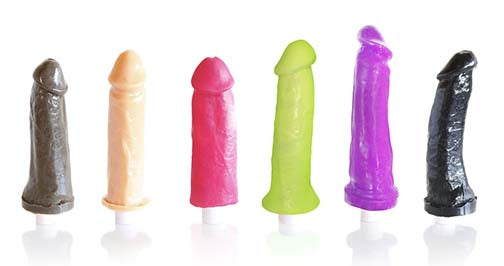The Science of Penis Casting
 Creating a homemade dildo, or a usable copy of your own penis, is rapidly turning into the new standard in ultra-custom sex toys. Below we break down the process from beginning to end and explain which materials and methods to avoid and which to employ to attain the best results.
Creating a homemade dildo, or a usable copy of your own penis, is rapidly turning into the new standard in ultra-custom sex toys. Below we break down the process from beginning to end and explain which materials and methods to avoid and which to employ to attain the best results.
Step 1: Molding
The first step in copying a penis is to create a mold, or a negative impression of it. This can be done in several ways, but for the absolute best reproduction with the highest level of detail, alginate mixed with water is hands-down the simplest, safest, and most precise method there is. Alginates are natural polymers that are derived from the cell walls of brown seaweeds; the same stuff you see floating in the ocean. Alginate is completely safe - even edible - and has multiple uses. Dentists u se it to make exact copies of teeth to fit braces, crowns, and retainers. Big food manufacturers use it as filler materials in their cheaper brand ice creams and hamburgers. Alginate has been in use in multiple products for decades and has proven over the years to be consistently safe and effective. When it comes to molding a penis, though, the details of your specific mix makes all the difference.
se it to make exact copies of teeth to fit braces, crowns, and retainers. Big food manufacturers use it as filler materials in their cheaper brand ice creams and hamburgers. Alginate has been in use in multiple products for decades and has proven over the years to be consistently safe and effective. When it comes to molding a penis, though, the details of your specific mix makes all the difference.
Accuracy
To achieve the most accurate mold possible, use a high-quality, body casting alginate mixed with warm water. Using cold water can bring on the dreaded 'shrinkage' effect, something no man wants when copying himself. Even an erect penis can be subject to a slight amount of shrinkage. An alginate that has been buffered to set in a specific amount of time with warm water will produce the best results, as knowing exactly when to insert your penis and when to pull it out is critical to molding an erect penis. A fast-set alginate is not ideal, as you'll need time to mix it with water, pour it into your molding container, and then insert your penis. Fast-set alginates typically won't give you enough time - the mixture will inevitably gel before you can insert yourself. Instead, you’ll want enough time to mix your alginate with water, pour it into your molding container, give yourself that last little bit of stimulus to ensure a complete erection, and then insert your penis.
mixed with warm water. Using cold water can bring on the dreaded 'shrinkage' effect, something no man wants when copying himself. Even an erect penis can be subject to a slight amount of shrinkage. An alginate that has been buffered to set in a specific amount of time with warm water will produce the best results, as knowing exactly when to insert your penis and when to pull it out is critical to molding an erect penis. A fast-set alginate is not ideal, as you'll need time to mix it with water, pour it into your molding container, and then insert your penis. Fast-set alginates typically won't give you enough time - the mixture will inevitably gel before you can insert yourself. Instead, you’ll want enough time to mix your alginate with water, pour it into your molding container, give yourself that last little bit of stimulus to ensure a complete erection, and then insert your penis.
Timing
Once inserted, you’ll want the mixture to set-up right away so you won't have time to lose your erection. In alginate terms, this is referred to as a 'delayed snap set'. A delayed snap set allows you enough working time to get yourself ready without requiring so much time that you'll lose your erection. Not many men can hold an erection for 5 straight minutes without stimulus. Clone A Willy Kits utilize a specially-formulated delayed snap set alginate, giving you a specific amount of time to mix, pour, get ready, and once the timer signals, insert your penis and hold for just 60-90 seconds. Less expensive, fast-set alginates (like dental alginates) don't allow for this precise timing and are usually designed to be mixed in very small quantities. Molding a penis takes a considerable amount more alginate and water, and thus considerably more mixing time. Fast-set alginates mixed in quantities larger than that for which they’re intended often begin to gel in some areas before you’re even finished mixing it all. You may still get a mold if you’re ready and really quick, but it likely won’t capture the detail you want. Without fine detail, your finished dildo might turn out looking like nothing more than an ill-defined blob. Whether molding your penis alone or with a friend, a buffered, delayed snap-set, body casting alginate with a workable time-frame is an absolute must.
Step 2: Casting
Materials
Once your mold is created, you'll need to fill it with something and let it set-up to get your final 'cast' piece. Many materials will cure within your alginate mold... plaster, wax, chocolate, silicone, epoxies, some urethanes, and other plastics, etc. But which material is best if you're after a safe, usable cast?
First, you’ll want to use a material that's both strong and safe... something stable that won't break down and/or leach chemicals into your body. A basic measure of the safety of a material is a simple smell test; if the material you're using has any smell, DO NOT USE IT internally. There are a multitude of chemicals that can 'leak' out of your finished dildo - some are easily absorbed by your body and might even be toxic. When creating a usable dildo, avoid latex, polysulfide rubbers, urethane rubbers, epoxy resins of any kind, and even some silicones. Silicones are the known gold-standard of sex toys due to their cleanliness, stability, and safety, but all silicones are not alike. Loopholes in regulations allow some manufacturers to call their materials "silicone" even if they contain as little as 10% of the real thing. These materials are known as hybrid silicones, though not everyone will admit to selling a hybrid. There are differences in 'real' silicones, too. For instance, a tin-cure silicone tends to break down over time, potentially causing deformation, brittleness, and shrinkage. There's also a risk of contamination, as tin-cure silicones will generally set-up no matter what's in them. If the pigment inside contains any potentially harmful metals, for instance, it'll still cure up and you'll be none the wiser. Platinum-cure silicones, on the other hand, are ideal because they won't be able to cure if there are contaminants inside. Also, once cured, the molecules remain highly stable and will not break down, leach toxins, or react with other materials over time. A finished platinum silicone cast will retain the same properties as it had the day it was made, meaning your finished toy will stay the same size, shape, color and feel for life.
Shrinkage
Another important factor with your casting material is SHRINKAGE. You don't want any material that will shrink while it cures up. The uncured material found in any molding/casting kit has what’s known as a linear shrinkage factor. Most uncured silicone resins will have a shrinkage factor of .007in/in or greater, and hybrids or compounds that include Latex are far worse - with shrinkage factors up to 10%! Even a little bit of shrinkage is unacceptable when copying a man’s penis. Look for a casting silicone that has a shrinkage factor of .001in/in. or less, as with any Empire Labs DIY kit. If you're looking for a realistic look and feel, a medically tested, body-safe platinum cure silicone is the best casting material there is. Use one and you won't be disappointed.
Detail
Another important consideration when casting is DETAIL. How realistic will your finished dildo be? There are many factors at play here, including viscosity, cure time, etc, and exploring them all would take a great deal of time and space. Clone A Willy's platinum silicones are specially formulated to capture every small detail... even a fingerprint will perfectly reproduce. The simplest, best way to determine how your dildo will turn out is to simply look at finished samples, or if buying online, at least check out any pictures available from the manufacturer. Regardless of whatever claims they make, if the images they have on display don’t look amazing, neither will your finished dildo. Keep in mind that these are the best replicas the manufacturer has been able to produce, and yours most definitely will not look any better.
What To Avoid
Stay away from MOLDING with plaster and plaster products as they are mostly exothermic (they release heat when curing). There is potential for burns to the skin when molding with plaster, and that’s not an area most men would like to scald. Because plaster becomes rigid, it is difficult to handle and remove, especially from body hair. Casting (forming your positive) with plaster is fine, as the plaster won’t come in contact with your skin (this is what Cynthia Plaster Caster did). A plaster cast, however, isn't usable and won’t be as realistic, durable, detailed, or as much fun as a softer, skin-like silicone cast.
Stay away from CASTING with chemically harsh materials. Many uncured resins contain phthalates (plastic additives that are easily absorbed in the body and have been shown to be possible endocrine disruptors). Phthalates can be found in almost all plastic or urethane resins. Also avoid products containing TDI’s, or toluene diisocyanates, which have been found to be carcinogenic. TDI's can be found in some cheaper silicones, so know what your silicone consists of. You’ll also want to stay away from latex. Aside from the fact that latex allergies are quite common (approx 8% of people), a latex cast will noticeably deform during cure, including a great deal of shrinkage.
General Tips
Above all, TRUST the company from which you’re buying. Check the manufacturer – are they reachable? Is there live operator assistance? Will the company back-up their product? Often a good measure of quality/reliability is whether or not you see the product on store shelves. Most shops won’t carry a product that doesn’t comply with all federal, state and local laws. Additionally, it must perform as it claims or the shop risks multiple returns and possibly even its reputation. Look for objective reviews on the product. Reviews posted directly on a website may not be valid, so look for articles in magazines and weblogs from names you trust.



